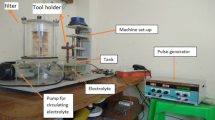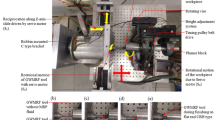Abstract
The present research article evaluates the performance of ultrasonic and chemically assisted double disk magnetic abrasive finishing (DDMAF) on polishing Si (100). The process parameters namely polishing speed, working gap, and pulse on time with five levels of each have been utilized to explore the surface roughness of polished Si (100). The statistical analysis revealed that polishing speed with a share of 71.1% was the most significant process parameter swaying the process performance on surface roughness. Furthermore, the share of working gap and pulse on time was found to be 3.04% and 1.65% respectively. The polishing speed interaction with pulse on time was found more influencing having share of 10.69% on surface roughness followed by working gap and pulse on time interaction with a share of 3.58%. The pooled regression equation with significant process parameters was used to obtain minimum surface roughness using genetic algorithm (GA) function available with MatLab 13 software package. The best polished face of Si (100) having surface roughness of 11.6 nm under optimum polishing condition has been achieved (1.5 nm on atomic force microscopy (AFM) scale). The scanning electron microscopy (SEM) and AFM inspections under optimum polishing condition of polished Si (100) were carried out. From the topographical inspection, it was observed that no scratch marks existed in the polishing direction. An evenly polished surface was obtained after polishing Si (100) under the influence of ultrasonic and chemically assisted DDMAF.












Similar content being viewed by others
Abbreviations
- adj.MS:
-
mean squares adjusted
- adj. SS:
-
sum of squares adjusted
- DF:
-
degree of freedom
- R a :
-
surface roughness of polished Si (100) (in nm)
- SS:
-
sum of squares
- t :
-
value of t-distribution
- V e :
-
variance of error
- X 1 :
-
polishing speed (rpm)
- X 2 :
-
working gap (mm)
- X 3 :
-
pulse on time (s)
- α :
-
confidence interval level
- R 2 :
-
coefficient of multiple determination
- β i, β ii, β ij :
-
constant coefficients
- ∆R a :
-
range of surface roughness model (in nm)
- F u :
-
force induced due to ultrasonic vibration
- F c :
-
tangential cutting force on abrasive particle
- F t :
-
total cutting force on abrasive particle
- F centrifugal :
-
centrifugal force on abrasive particle due to the rotation of primary magnet
- T :
-
polishing time
- ω:
-
angular velocity of primary magnet
- v :
-
tangential velocity of Al2O3 abrasive particle
- r :
-
radial distance of FMAB from the center of the primary magnet
References
Fox M, Agrawal K, Shinmura T, Komanduri R (1994) Magnetic abrasive finishing of rollers. CIRP Ann Manuf Technol 43:181–184. https://doi.org/10.1016/S0007-8506(07)62191-X
Sreejith PS, Udupa G, Noor YBM, Ngoi BKA (2001) Recent advances in machining of silicon wafers for semiconductor applications. Int J Adv Manuf Technol 17(3):157–162. https://doi.org/10.1007/s001700170185
Muratov VA, Fischer TE (2000) Tribochemical polishing. Annu Rev Mater Sci 30:27–51
Zantye PB, Kumar A, Sikder AK (2004) Chemical mechanical planarization for microelectronics applications. Mater Sci Eng R Rep 45:89–220. https://doi.org/10.1016/j.mser.2004.06.002
Wang J, Feng P, Zhang J (2017) Investigations on the critical feed rate guaranteeing the effectiveness of rotary ultrasonic machining. Ultrasonics 74:81–88. https://doi.org/10.1016/j.ultras.2016.10.003
Geng D, Zhang D, Li Z, Liu D (2017) Feasibility study of ultrasonic elliptical vibration-assisted reaming of carbon fiber reinforced plastics/titanium alloy stacks. Ultrasonics 75:80–90. https://doi.org/10.1016/j.ultras.2016.11.011
Sharma V, Pandey PM (2016) Optimization of machining and vibration parameters for residual stresses minimization in ultrasonic assisted turning of 4340 hardened steel. Ultrasonics 70:172–182. https://doi.org/10.1016/j.ultras.2016.05.001
Mulik RS, Pandey PM (2011) Magnetic abrasive finishing of hardened AISI 52100 steel. Int J Adv Manuf Technol 55:501–515. https://doi.org/10.1007/s00170-010-3102-8
Kala P, Pandey PM (2015) Comparison of finishing characteristics of two paramagnetic materials using double disc magnetic abrasive finishing. J Manuf Process 17:63–70. https://doi.org/10.1016/j.jmapro.2014.07.007
Kala P, Pandey PM (2015) Experimental investigations into ultrasonic-assisted double-disk magnetic abrasive finishing of two paramagnetic materials. Proc Inst Mech Eng B J Eng Manuf 954405415581153
Li Y, Wu Y, Wang J (2012) Precision manufacturing of fused silica glass by combining bound-abrasive polishing with ultrasonic vibration. In: 6th Int. Symp. Adv. Opt. Manuf. Test. Technol. (AOMATT 2012). p 841606
Sihag N, Kala P, Pandey PM (2015) Chemo assisted magnetic abrasive finishing: experimental investigations. Procedia CIRP 26:539–543. https://doi.org/10.1016/j.procir.2014.07.067
Sihag N, Kala P, Pandey PM (2015) Experimental investigations of chemo-ultrasonic assisted magnetic abrasive finishing process. Int J Precis Technol 5:246–260
Sihag N, Kala P, Pandey PM (2017) Analysis of surface finish improvement during ultrasonic assisted magnetic abrasive finishing on chemically treated tungsten substrate. Procedia Manufacturing 10:136–146. https://doi.org/10.1016/j.promfg.2017.07.040
Pineiro A, Black A, Medina J (2013) The use of potassium peroxidisulphate and Oxone as oxidizers for the chemical mechanical polishing of silicon wafers. Wear 303:446–450. https://doi.org/10.1016/j.wear.2013.03.030
Pandey K, Pandey PM (2017) Chemically assisted polishing of monocrystalline silicon wafer Si (100) by DDMAF. Procedia engineering 184:178–184. https://doi.org/10.1016/j.proeng.2017.04.083
Pandey K, Pandey U, Pandey PM (2018). Statistical modeling and surface texture study of polished silicon wafer Si (100) using chemically assisted double disk magnetic abrasive finishing. Silicon, 1–19. doi: https://doi.org/10.1007/s12633-018-9961-6.
Pandey K, Pandey PM (2018) Use of chemical oxidizers with alumina slurry in double disk magnetic abrasive finishing for improving surface finish of Si (100). J Manuf Process 32:138–150. https://doi.org/10.1016/j.jmapro.2018.02.007
Mulik RS, Pandey PM (2012) Experimental investigations and modeling of finishing force and torque in ultrasonic assisted magnetic abrasive finishing. J Manuf Sci Eng 134(5):051008. https://doi.org/10.1115/1.4007131
Montgomery DC (2008) Design and analysis of experiments. John Wiley & Sons
Syswerda G (1993) Simulated crossover in genetic algorithms. Found Genet Algorithms 2:239–255
Author information
Authors and Affiliations
Corresponding author
Additional information
Publisher’s note
Springer Nature remains neutral with regard to jurisdictional claims in published maps and institutional affiliations.
Rights and permissions
About this article
Cite this article
Pandey, K., Pandey, P.M. An integrated application of chemo-ultrasonic approach for improving surface finish of Si (100) using double disk magnetic abrasive finishing. Int J Adv Manuf Technol 103, 3871–3886 (2019). https://doi.org/10.1007/s00170-019-03829-5
Received:
Accepted:
Published:
Issue Date:
DOI: https://doi.org/10.1007/s00170-019-03829-5




